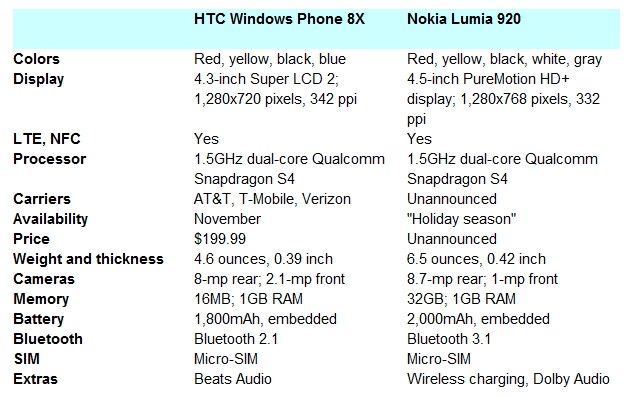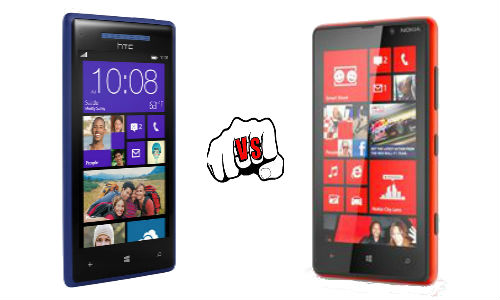Due to the Windows 8 release, there’re several smartphone manufacturers that plan to output
smartphones based on Windows Phone 8.
On September 5th, Nokia held an event to officially introduce its
latest Windows Phone 8 smartphone Nokia Lumia 920 and 820. Right after the Nokia WP8 smartphones released, HTC soon
released its brand new wonderful Windows Phone 8 smartphones on HTC WP8
September 19th event, the HTC 8X and HTC 8S. Today, I have collected some materials regarding Lumia 920
and HTC 8X to make a brief comparison between these two Windows Phone 8
smartphones. The below picture would show some detailed specs of HTC 8X and
Lumia 920. Check the comparison below:
On the appearance, these two smartphones
look very similar to each other. HTC 8X has abandoned its previous design like
HTC One X, much fitter to Windows Phone 8 screen display. HTC's phone is
significantly smaller, lighter, and thinner than the Lumia 920, which may give
it a leg up for those who prefer more pocketable devices.
Displays
The Lumia 920 has the slightly larger
display, 4.5 inches as opposed to the HTC Windows Phone 8X's 4.3 inches. Both
smartphones own the same HD screens while HTC 8X might be a little advantageous
for its higher pixel density, 342 pixels per inch versus the Lumia's 332 ppi,
yet still enough to produce excellent video experience for users to watch HD movies on smartphones. Both use similar LCD screen technology with IPS, or
in-plane switching.
Camera
The 8X includes HTC's image chip and
8-megapixel camera, which are included in the HTC One X and One S phones.
Shutter lag is virtually nonexistent, and photo quality is very high. On the
other hand, Nokia's 8.7-megapixel Pureview shooter could be great -- or it
might disappoint like the Lumia 900's did, since it doesn’t own a relatively
high sensor to let the light stream in just like that of Pureview 808.
Processor
and performance
With the same 1.5GHz dual-core Qualcomm
Snapdragon S4 processor, the same Windows Phone 8 OS, and the same 4G LTE
speeds, the 8X and the Lumia 920 should run neck and neck for performance.
On the Bluetooth front, HTC made the
strange decisions to give the 8X Bluetooth 2.1, whereas the Lumia 920 follows
Bluetooth 3.1 standards. The best-case scenario would see both phones with
Bluetooth 4.0 for easy tapping and pairing. At least with NFC on both handsets, there's room to pair with third-party
accessories using the near field communication standard.
Battery
Nokia's 2,000mAh embedded battery edges the
8X's 1,800mAh equally nonremovable ticker. But the Lumia 920 has a larger
screen display, which may eat more power than that of HTC 8X. Meanwhile,
depending on the usage and brightness settings, runtime per charge could be
shorter, longer, or identical. The PueMotion HD technology might even draw more
battery, since it requires a voltage surge to transition from one video frame
to the next.
Memory
The Lumia 920 has 32GB of onboard memory,
plus 7GB of free Microsoft SkyDrive storage. HTC's 8X comes in a 16GB model,
and while SkyDrive is available on every Windows Phone, HTC didn't announce
plans to offer it free. Both phones have 1GB RAM, and neither comes with a
microSD card slot for additional storage.
Carrier
and pricing
HTC has the benefit of enlisting carriers
to help rally customers to the 8X. The phone has a price ($199.99) on three
carriers: AT&T, T-Mobile, and Verizon. Though Nokia hasn’t yet announced
U.S. carriers, there are plenty of rumors that point to an October or November
Lumia 920 launch on AT&T.


No comments:
Post a Comment